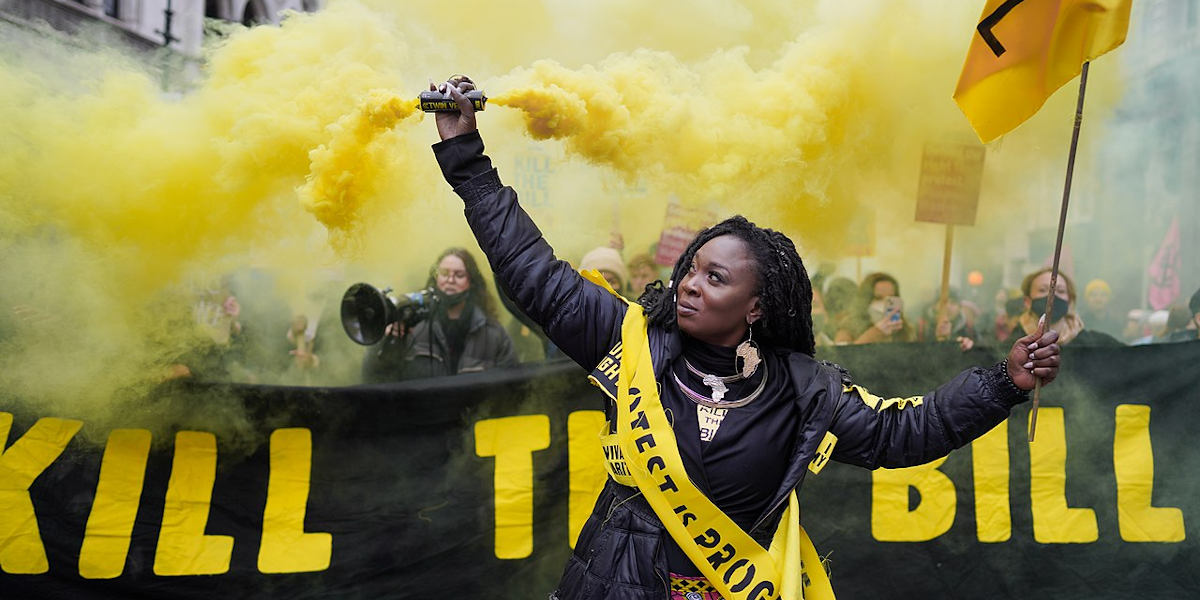Title: Abolition Revolution
Authors: Aviah Sarah Day & Shanice Octavia McBean
Publisher: Pluto Press
Year: 2022
With growing calls to defund the police, for a complete upheaval of the prison system and to end school exclusions, abolitionist politics in Britain has never been more important. And in Aviah Day and Shanice McBean’s Abolition Revolution, the case for revolutionary politics and a pathway to abolition is clear. The authors of this insightful and detailed book break down the case for abolition into 16 theses – ranging from the colonial roots of policing and the need for intersectionality in abolitionist movements to the current systems of criminalisation and how we can collectively tackle them.
Abolition Revolution isn’t simply a book based in theory or concepts, which is crucial to how we understand the different forms of oppression and their roots. It is also a practical guide that outlines how abolition isn’t a utopian concept and how we can move forward as a society using abolitionist principles. Day and McBean – who both have a background in community organising – offer a much-needed contribution to the field of abolitionist literature that will suit readers looking for an introduction to this politics as well as those already actively involved in abolitionist organising.
Beyond police power
There’s no shortage of examples when it comes to highlighting the violence of the police in the UK, with one of the most recent cases being that of Chris Kaba. On 5 September, the 24-year-old was shot and killed by a Metropolitan Police officer following a car chase in south London. The police claimed the car Kaba was in was flagged for a firearms incident the previous day. However, it was later revealed that Kaba was unarmed.
Since 1990, there have been 1833 deaths in police custody or following contact with the police in the UK. In the first part of the book, the authors take the reader through this inherent and structural violence of the state’s institutions and how this harm intersects with race, gender, class and so on.
They begin by looking at the contrast between the police killings of Mark Duggan and Sarah Everard and how they were contextualised in very different terms. Duggan was painted as a ‘gang’ member and criminal by both the police and the media and was subjected to a smear campaign, whereas Everard’s death introduced many to ‘the horrors of British policing for the very first time – horrors black communities had been living like an unbroken nightmare for decades’.
Despite the police ban, the feminist abolitionist group, Sisters Uncut, assumed leadership for the vigil, which the Met Police responded to with violence
Day and McBean also analyse the idea of ‘policing by consent’ and why it is crucial we withdraw this consent and not buy into the police’s illusion of change, which tends to lead to the police asking for more power and resources. They highlight the Clapham Common vigil held for Sarah Everard and how the initial organisers, Reclaim These Streets, sought police consent to hold a vigil, which was denied. But despite the police ban, the feminist abolitionist group, Sisters Uncut, assumed leadership for the vigil, which the Met Police responded to with violence.
The authors use this key example to argue that resistance to the state must be escalated if we want to see real change, and this needs to start with the withdrawal of consent. ‘The concept of withdrawing consent to policing can bridge the gap between reformist and abolitionist demands, as the act of withdrawing consent can be both pragmatic, whilst creating a gateway to more radical and revolutionary thinking,’ Day and McBean explain.
Systems of criminalisation
The authors then focus on the systems of criminalisation that exist in British society and how people have fought back. The power and ‘radical energy’ of youth movements are the focal point. They discuss the student protests against increasing tuition fees in 2010, and the work being done around the school-to-prison pipeline and school exclusions.
Day and McBean also dedicate a chapter to looking at the organising being carried out by incarcerated people and how they play a key part in abolitionist movements, especially in highlighting the brutal and violent conditions of prison.
Abolition isn’t just about dismantling policing and prison but also the abolition of the world’s borders. Migrants have become increasingly criminalised with the expansion of the UK government’s ‘hostile environment’, which has seen the majority of legal routes to this country shut down, as well as the increased use of detention centres. Abolition Revolution details the inherently violent nature of borders and their roots in the protection of colonial and imperial wealth. ‘Abolition must mean the free movement of people: open borders is abolition and abolition is open borders,’ Day and McBean write.
The book concludes with a bold manifesto on how abolition would work in real terms, outlining how systems of care and transformative approaches would better serve our communities when dealing with harm. The authors write that health and care-based solutions that prioritise prevention and harm reduction have been proven to work and should be run in partnership with local communities and workers.
Abolition Revolution will not only inform and educate readers on abolitionist approaches but will also light a fire within your soul, allowing the vision of revolution to become more tangible. As Day and McBean write, ‘Abolition is the pre-drinks, revolution is the sesh.










